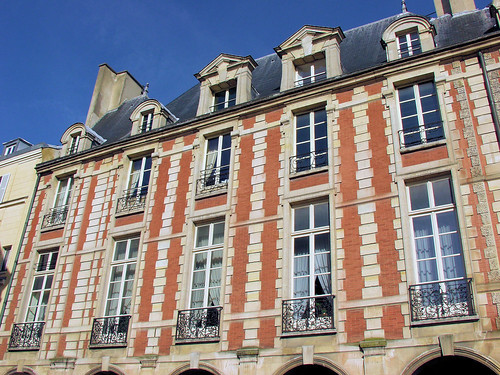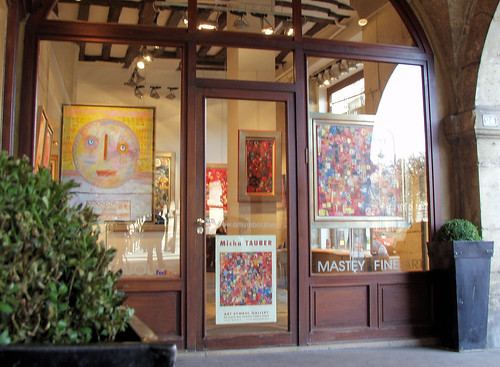You don’t so much visit the Place des Vosges as be the Place des Vosges. To reach that blessed state you should stroll from the Metro Bastille, up the Rue St Antoine, then right into the Due de Birague. Then in the distance you will see that incredible warm glowing terracotta red of the brick, offset by the careful march of studied beige stone. And you are there.

To get fully into the appropriate state of mind you should then make a slow progress, a complete circuit of the arcades, stopping here and there to enjoy the objet d’art in the boutiques that line the Place. I don’t know if any academic has so named it, but there is definitely a “school of the Place des Vosgesâ€. This is modern art, but distinctly accessible modern art.

A particular feature are sculptured figures, of humans and animals, made from ‘found, objects. This seems to be a particularly French obsession, but here there’s a genuine sculptural quality, an observation of shape and movement, that you won’t find in overtly similar works to be found in one atelier in every village.As for the paintings, there’s no pseudo-impressionist dabbing, except from the man who’s set up his motorcycle as an impromptu stall for the tourist trade. Instead there’s colourful, lively but none-too-threatening canvases, large mostly. Just perfect for that New York loft or Parisien grand hotel.What you won’t find are price tags. It is that old story of “if you have to ask…â€In an appropriately contemplative state, it is time then for a stop at one of the cafes at either corner; one’s nearly always in the sunshine. I always have a hot chocolate, one of those little traditions, but if you prefer, a glass of champagne might be in order.
For then you can sit and drink in the glorious architecture – not grand in scope like the Louvre or excited moderne like the Eiffel Tower, but domestic – grand but somehow also modest in its uniformity. Some very blue-blooded, and very rich, people have lived, and probably still do live here, but they don’t choose to show that face to the world. London’s St James’s Square was to be built on the same model, but you couldn’t get the British to fall into such even lines. Although they did later, for the terraces around Regent’s Park. If you visit there you’ll see the cars of the rich lined up, but not here. Paris would be so much more attractive without the cars, but you can’t see the French independent streak taking that. Today lined up around this grand place are battered people carriers, ancient Renaults and the nondescript little city cars that are sometimes lifted into tight Parisien parking spots.
There’s plenty to consider – if you’ve in a mood for grim history think of July 1, 1599, when Henry II of France was enjoying one of his favourite past-times, jousting. (Must have been tricky that, jousting against your king – you didn’t actually want to win, but you didn’t want to put up a poor show either.)
When the lance of Gabriel Montgomery, captain of the king’s guard, shattered on his monarch’s shield he probably thought for a second “well done”, before he realised that there had been a “freak accident” (for once a fair use of that term). Splinters from the lance had penetrated the king’s closed visor and penetrated his brain. The king died a few days later, and within a few short years the nation was convulsed by what would come to be called the Wars of Religion.
But usually I prefer to think of the great figures who’ve lived here, and the days when this was the very center of French cultural, social and even political life. Victor Hugo is the best remembered (he’s got his own museum in one corner – sadly not particularly exciting and for enthusiasts only). But I think of the 17th-century women who swept through here in glittering gowns: the courtesan Marion Delorme who ran the most glittering salon of her day, and had an astonishingly fertile literary afterlife, or the aristocratic Marie de Rabutin-Chantal, marquise de Sévigné, whose prolific letter-writing has preserved her fame.

After the Place? Well I stroll into the central park for a quick visit to the equestrian Louis XIII, then often I wander down the Rue des Francis Bourgeois, towards the Pompidou Centre. It is one of my favourite Parisien shopping streets – great for quirky jewelry and with some excellent boutiques. But if that sounds a little expensive, then on the Rue du Pas de la Mule, to the north of the square, is a lovely little Corsican restaurant, the Auberge Chez Rosita, that I rather fancy.